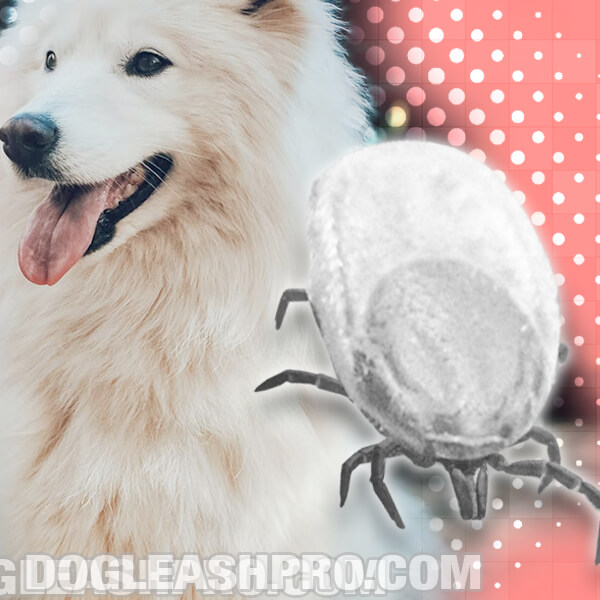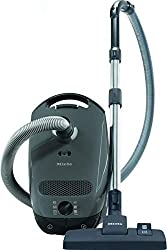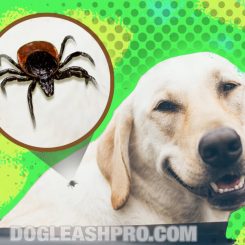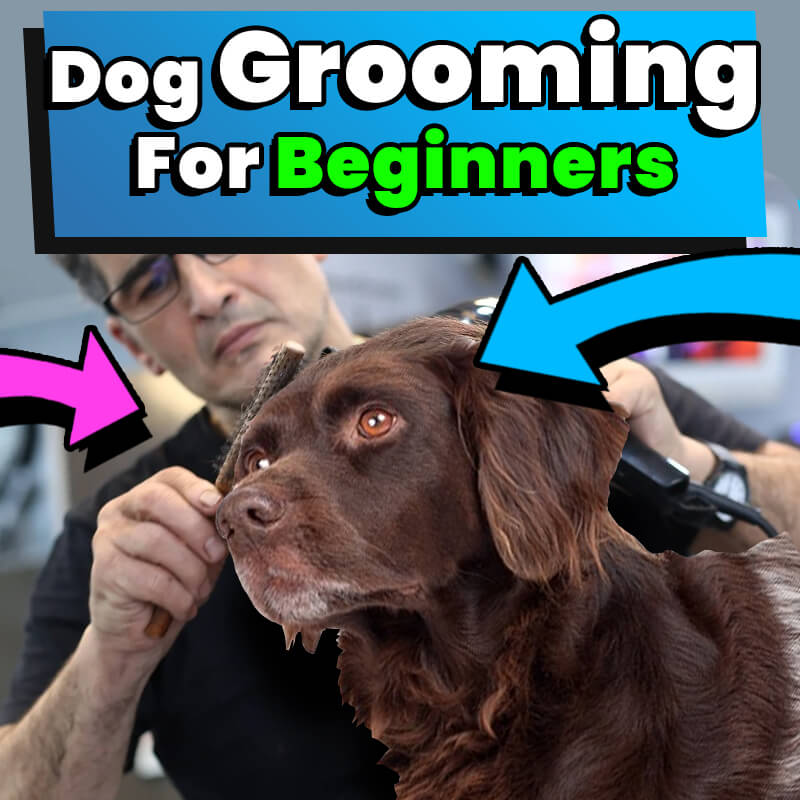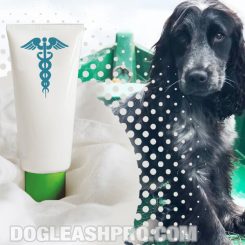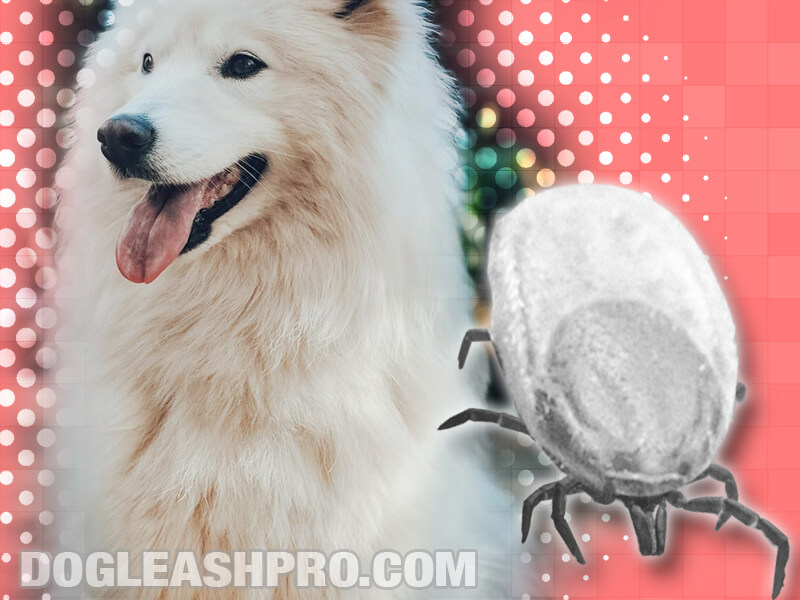
As you’re removing the Dried Dead Tick from your dog’s skin, you notice an Engorged Tick fell off your dog. At first, you thought it might be a tiny kibble piece or a speck of small dirt. But upon a closer look, it was an Engorged Tick! Eww!
Now you may be wondering, “What should I do if an Engorged Tick Fell Off my Dog?”
Table of Contents
Full Tick fell off dog: Here’s what to do next!
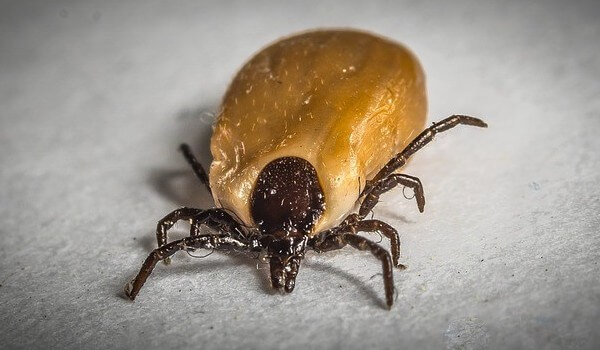
If a full or Engorged Tick fell off your dog, you’ll want to do the following steps:
- Get a small Ziploc bag and pour some rubbing alcohol inside.
- Pick up the Engorged Tick that fell off your dog with a thin pointy tweezer and drop the full Tick into the Ziploc bag with the rubbing alcohol. The alcohol will be fatal to the full Tick.
- Seal the small Ziploc bag to prevent the Engorged Tick from escaping.*
- Perform a thorough examination of your dog’s head, neck, body, and legs. Try to remember where you think the Engorged Tick fell off from. If the Engorged Tick fell off of your dog’s neck, you’ll want to check his neck area.
- If you find other full Ticks on your canine friend’s neck or body, you’ll want to remove them using a tweezer.
- Next, it’s crucial that you clean and disinfect the Tick bite site and the surrounding areas using disinfectants like hydrogen peroxide or 70% isopropyl rubbing alcohol as a first aid antiseptic. Either of these will disinfect the bite wound. You can dap some onto a cotton pad and wipe the bite site gently and slowly.
*If you would like your dog’s vet to examine the Engorged Tick to find out if your dog was infected with any disease-causing bacteria, you’ll want to keep the Ziploc bag and bring it with you to the vet’s office.
You may like: How Do I Know If My Puppy Will Survive Parvo?
If you notice that the Tick bite site is developing a skin infection due to your pooch scratching or biting the area after the Engorged Tick fell off, go ahead and apply some antibiotics to help with the skin infection.
You can also apply a thin layer of anti-itch cream to alleviate that itchiness. This will allow your dog’s skin to heal quickly and nicely.
In most cases, your furry friends will go about their daily lives as normal after being bitten by Ticks.
In some cases, they could develop red, itchy, or inflamed skin. If you notice any red dots or splotches, then you’ll want to monitor their skin closely. Sometimes, skin infections can lead to other serious health issues such as losing hair.
Want more information? Check out this guide to Dog Losing Hair Around Eyes. We’ve included the top 9 reasons that can cause dogs to lose their hair and what you can do to help.
Depending on where you live (wooded or grassy areas), some Ticks may carry tick-borne diseases such as Lyme disease. When the Ticks feed on your pooch, they can transmit Lyme disease or other bad bacteria and diseases to your dog. These diseases usually take up to 48 hours to develop.
This is why we highly recommend that you keep a close eye on your K9 friends after finding and removing the Engorged Ticks. You’ll want to look for any signs and symptoms of skin infection or illness due to tick-borne diseases.
Some dogs may not feel well when they are infected by the Engorged Tick. Their behavior may change such that they may have a loss of appetite or become lethargic and aren’t as active as before. In this case, it’s best to contact your dog’s vet as soon as possible.
Handy Hint: If your fur babies are feeling sick and losing their appetite, there are several ways to encourage your K9 friends to eat again. Check out How to Get Your Dog to Eat When Sick to find out what they are so that your pooch can eat again and become healthy.
What happens when an Engorged Tick falls off my dog?
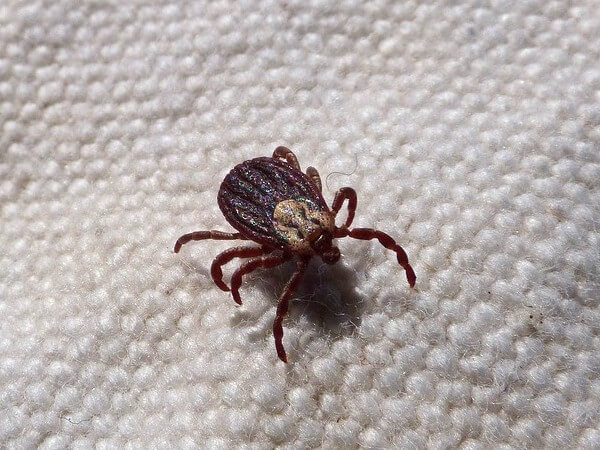
If an Engorged Tick falls off your dog’s skin, your fur baby may start to develop inflamed, itchy, and red skin. However in most cases, within the first few hours, your pooch may not have any adverse side effects or symptoms at all.
Depending on which stage of the life cycle the Engorged Tick is in will highly affect what will happen to that full Tick when it falls off your dog.
For instance, if the Engorged Tick is currently in the larvae or nymph stage, it will crawl somewhere and hide so that it can finish digesting its bloody meal. While finishing up its bloody meal, it will molt and grow and wait around to find its next host so they can continue their feeding.
If the Engorged Tick is an adult female, then once it falls off your four-legged friends, they will tend to their purpose – which is to mate. After partnering, the adult female Engorged Tick will lay eggs and then die in a dark area.
When the Engorged Tick is an adult male, it will also mate after falling off your dog’s skin. After partnering, it will naturally die.
Should you find a brown dog Tick engorged with blood after falling off your dog, then it will most likely live for up to two or three months longer than other Engorged Ticks.
Engorged Ticks that fall off your dog’s skin in a dry environment such as inside your home may gradually lose water and become dry due to the natural process of evaporation. Over the next three weeks, as they continue to lose water, they will most likely die. This is why you’ll usually find dead Ticks that are dried.
Be extra careful when you see a brown dog tick fall off your dog. Most brown dog ticks can and will survive in dry environments. Since they are able to survive and live longer in dry environments, there’s a possibility that they can cause an infestation in your home.
Fun Question: If your dogs find an Engorged Tick or a brown dog tick on the floor or carpet, is it safe for them to eat it? Check out Can Dogs Eat Bugs? to find out!
Engorged Tick on Dog: Does it die when it’s Engorged?
No, it is not likely that the Tick will die when it is Engorged. When Ticks are Engorged, it means that they are feeding on your dog or dormant.
However, there is a possibility that the Engorged Tick buried on your dog’s skin could die. This is usually the case if your dog took oral medications to combat ticks and fleas.
After the Tick’s first bite, the chemicals in topical tick or flea treatments and other pest preventatives usually take about 10 minutes to kick in and make their way into the Tick’s system. This is why you may sometimes find a dead Tick that’s Engorged on your dog’s skin.
Don’t panic when you see this. It just means that the flea treatment is working. Simply do your best to remove the Dead Engorged Tick from your dog’s skin with a pointy tweezer. Try to remove the Dead Engorged Tick in one piece.
The good news is that generally dead ticks won’t transmit any disease-causing bacteria unless you accidentally squish their body with the tweezer during the removal process.
This is why anti-tick treatments are extremely helpful, especially if you live in a wooded or grassy area. When dogs have an anti-tick treatment, the Engorged ticks will likely die after their first bite.
However, there are some owners that prefer not to apply ointments or anti-tick sprays directly on their dog’s skin because they believe these treatments can distress the tick and cause it to release disease-causing bacteria through their saliva.
You may be interested in: White Specks in Dog Poop (Not Moving) – What Should You Do?
What do you do if you find an Engorged Tick On Your Dog?
It is very likely that there are more Engorged Ticks on your dog when you find one. As soon as you notice one, go ahead and thoroughly check your dog’s body to find other hidden Ticks. The best places to start looking are your dogs’:
- Face.
- Ears.
- Neck.
- Body.
- Front legs.
- Hind legs.
- Torso.
- Anal area.
With the help of either a hairdryer or tick comb, you can quickly find the Engorged Ticks hiding under your dog’s coat and on his skin.
Make sure you have the tweezers ready because once you’ve located the Engorged Ticks, you’ll want to remove them as soon as you can. If you don’t have a tweezer, feel free to use other tick removal products.
When you are removing the Engorged Ticks, it’s important that you do not irritate them. Many dog owners may apply rubbing alcohol or products like Vaseline directly onto the Engorged Ticks thinking that this may cause the Ticks to fall off quickly and easily.
However, this method only further irritates and triggers the Engorged Ticks to continue to hold onto your dog’s skin more tightly and firmly.
As a result of this irritation, the Engorged Ticks may react by regurgitating saliva or vomit out of their system and this will go into your dog’s bloodstream. If they carry disease-causing bacteria or any other bad bacteria, this may get transmitted to your furry friends.
This is why it’s important that dog handlers do not use rubbing alcohol, hydrogen peroxide, or Vaseline directly on the Engorged Ticks to get rid of them.
Be extra careful when you’re using the tweezer and remove it slowly with just the right amount of pressure. Try not to rush through the tick removal process as doing so could cause you to squish the Engorged Tick or cause the body to fall off while its head is still buried deep in your dog’s skin.
Squishing the Engorged Tick can also cause it to regurgitate vomit or saliva and transmit potential disease-causing bacteria into your dog’s bloodstream.
Once you’ve seen the Engorged Tick, remove it immediately. Do not wait around to remove it as this could only increase the risk of the disease being transmitted from the nasty Engorged Tick to your precious K9 friends.
Some dog handlers may even try to burn the Engorged Tick, but this is not a good idea either. Just like squishing the Engorged Tick, when you try to burn the Engorged Tick, it can irritate the tick and cause it to regurgitate and transmit saliva and vomit to your dog.
In some cases, you may even burn your dog’s coat and skin when trying to burn this nasty pest. For these reasons, it’s best to avoid using any burning method.
Before you begin the tick removal process, you’ll want to have the following items ready and handy:
- A pair of latex gloves.
- A pointy tweezer, a tick twister, or a tick key.
- Small Ziploc bag or any small plastic bag to temporarily store the tick after removal.
- 70% rubbing alcohol (isopropyl) as first aid antiseptic, or hydrogen peroxide.
- Cotton balls.
- Antiseptic or antibiotic ointments.
All of these items are crucial during the Engorged Tick removal process. It is recommended that you wear latex gloves to protect your skin at all times during this process. Doing so also prevents any fluid transfer from the tick or dog to your skin.
After the tick removal process or after the Engorged Tick Fell Off Dog, you’ll want to keep your dog’s skin clear of any fungus or bacterial growth. Next, let’s go over which antiseptic product you should apply on your dog.
Best Antiseptic Product to use once Engorged Tick Falls Off Dog
Applying antiseptics after removing the Engorged Tick is a crucial step that should not be missed or ignored. That’s because after the tick removal process or after the Engorged Tick falls off your dog, the tick bite site is prone to bacterial growth which can lead to pyoderma, a bacterial skin infection.
By applying antiseptics, it helps to reduce the risk of infection and stop the growth of both fungus and bacteria.
Best Antiseptic Spray For Dogs
This is why I use the Curaseb medicated antiseptic spray for my dogs whenever they have ticks. As soon as I noticed the Engorged Tick falling off my dogs, I immediately applied the Curaseb antiseptic spray so that it can help prevent infections and remove bad bacteria.
Imagine how many vet visits you can avoid and how much money you can save just by applying this antiseptic spray.
I rely on the Curaseb Antiseptic spray for my dogs because of the following reasons:
- Made in the USA.
- Produced in small batches in federally regulated manufacturing facilities to ensure safety and quality.
- Veterinary strength medicated formula for dogs and other pets.
- Prevent and relieve skin infections.
- Eliminates Bacteria, yeast, fungus, ringworm, and pyoderma.
- Does not sting the tick bite site because it is alcohol-free.
- Relieves itchiness and hot spots.
- Contains aloe and vitamin E to nourish and soothe rashes, redness, and skin irritations.
- Easy to use.
- Has a cucumber melon scent.
What I like about this product is that it is great for other purposes too. When my dogs have hot spots, acne, or other allergic skin reactions, this antiseptic spray is my go-to solution.
With over 18,600+ unique reviews from dog owners on Amazon and a rating of 4.5 out of 5 stars, it’s no wonder why many pet owners are choosing to use this antiseptic spray on their furry friends over other products on the market.
Check out: Can You Use Bactine On Dogs?
How to remove Engorged Tick from Dog? 6 Easy Steps
If you find an Engorged Tick (or two) on your dog, don’t fret. Here are 6 easy steps to remove Engorged Tick from dog.
1. Use a tweezer to remove the Engorged Tick
Using a thin pointed tweezer, you’ll want to firmly hold onto the Engorged Tick’s body as close to the dog’s skin as possible. Avoid applying too much force as doing so could separate the tick’s body from its head.
Doing so could also irritate the tick and cause it to regurgitate saliva or vomit out of its system. If their saliva contains disease-causing bacteria or any other bad bacteria, this may get into your dog’s bloodstream.
With a gentle pull, slowly and gradually pull the Engorged Tick out.
2. Remove the Tick’s mouth and teeth if it’s still stuck on your dog’s skin
At times, the Engorged Tick’s mouth and teeth may still be stuck on your dog’s skin after the removal. If this is the case, use the tweezer to remove the mouth and teeth that are still stuck on your dog’s skin.
If you’re unable to successfully remove the remaining parts, it’s best to consult your vet. The vet may ask you to leave the remaining parts alone as they will eventually fall off or your dog’s body will learn to attack the foreign object on the skin to get rid of it.
3. Disinfect the tick bite site with soap and water
As soon as the Engorged Tick is removed from your canine friend’s skin, you’ll want to disinfect the bite site with soap and water.
4. Place the Engorged Tick in a Ziploc bag and write down the time and location of the bite site
After removing the Engorged Tick, you’ll want to place it inside a closed Ziploc bag. On the front of the Ziploc bag, you can jot down the location of the tick bite and the time you removed it.
Jotting down the time and date of the Engorged Tick removal is important. That’s because any disease transmitted from the Tick to your furry friend during their feeding or during the removal process is not detectable until 4 or more weeks after the bite.
That’s about a month’s time and it’s easy to forget how your four-legged friends got Lyme Disease (for instance) if you didn’t note it down. Alternatively, if you have a doggy journal, you can note that information in there so you can keep track of the tick bites all in one place.
You can bring this Ziploc bag with the Engorged Tick inside to the vet if you’re concerned that your pooch may be infected with disease-causing bacteria. Your vet could take a look at the tick to identify the type of tick and any potential disease or illness associated with that particular species of tick.
If you keep a journal record of your dog, you can take a picture of the tick, print it out, and tape it under that time and location you wrote down.
5. Avoid flushing the Engorged Tick down the toilet
If you would like to get rid of the Engorged Tick after the removal process, do not flush it down the toilet. This is a bad idea because it is possible for some Ticks to survive. If the Ticks do survive, there’s a possibility that they will infest other places or areas.
Instead, you can submerge the Engorged Tick in rubbing alcohol or wrap it in tape to get rid of it or destroy it.
6. Monitor the tick bite site daily to check for skin rashes and inflammation
After the tick removal process, you’ll want to monitor the tick bite site daily to check for any changes such as skin inflammation, scratches due to itchiness, rashes, or redness. If it helps, we highly recommend that you trim the fur around the tick bite site so you can monitor the area easily.
You can jot down in your doggy journal any changes you see in the dog’s skin.
Related Article: Dog Losing Hair Around Eyes? (9 Top Reasons + What To Do)
After removing the fully Engorged Tick, here’s what you can do:
1. Apply anti-tick or tick prevention products on your dogs
You’ll want to apply tick prevention products on your canine friends. This can be in the form of soft chews, spray, or topical treatments.
When it comes to flea and tick collars, they may work for some dogs. However, we’ve heard way too many complaints from many dog owners that their dogs were getting severe allergic reactions from wearing flea and tick collars.
Some dogs even had mild to severe seizures, became sick, or had a change in behavior such that they became aggressive towards other pets in the house.
There were some dog owners who lost their beloved canine friends after they wore the flea and tick collars. One dog owner informed me that she had a healthy and active dog. A month after wearing the flea and tick collar, her pooch had about four tumors growing on the neck where the collar was. Her dog could no longer walk and all of this happened so suddenly.
2. Vacuum your carpet and floor to get rid of any Engorged Tick lying around
If you live in a grassy or wooded area with tons of grass or trees, then there is a high likelihood that there are Engorged Ticks feeding on your dogs or are inside your home.
After the Engorged Tick finishes feeding off your dog, it will fall off your pup’s skin and crawl into a dark area where they can hide and digest their bloody meal. While hiding, they’re also trying to find their next host or prey to latch onto and feed on again.
This is why you’ll want to invest in a powerful vacuum cleaner that can seamlessly transition from carpet to hardwood floor and vice versa. You’ll want one that comes with several crevice tools to reach different areas in your house, including the furniture, curtains, and walls.
Sometimes, Engorged Ticks like to hide in the corner of your living room and you’ll want a vacuum cleaner that can get into those corners and leave your house clean and fresh.
With two furbabies, we use this Miele vacuum cleaner. It is quiet and comes with six different suction power settings specific to whichever surface you need to clean. The Miele vacuum cleaner also comes with different upholstery tools which are extremely helpful.
After 5 years of using this vacuum cleaner, it is still like new. Best of all, it comes with a 7-year manufacturer warranty on motor and casing and a 1-year manufacturer warranty on parts and labor.
3. Hire a pest control professional to come and get rid of all the ticks in your home
If you have a busy schedule and would prefer to have a professional come into your house and get rid of the ticks, it’s a good idea to hire a pest control professional. They will help to remove all of the ticks in your home and this will also prevent any future tick infestation.
4. Monitor your dog’s skin, temperature, behavior, and appetite
It’s crucial to keep an eye on your canine friends over the next few weeks. You’ll want to see if there are any unusual changes in behavior, if their appetite and temperature decrease or increase, and whether the affected skin is healing nicely.
The changes may not be immediate and may take a few days to take effect. For instance, even your vet may not be able to detect any tick-borne disease or affliction until four or more weeks after the tick bite. This is why it’s important to monitor your furry companions closely for at least up to a month.
If you do notice any unusual changes, we recommend that you consult with your dog’s vet immediately to find out if your pooch contracted one of the following diseases that the Engorged Tick was carrying.
Upon examination, your vet will inform you of any potential diseases such as:
- Anaplasmosis.
- Babesiosis.
- Ehrlichiosis.
- Encephalitis.
- Lyme disease.
- Piroplasmosis.
- Rocky Mountain spotted fever.
One of the most common diseases dogs get from Ticks is Lyme disease. This condition is serious and requires immediate medical attention. It can cause the following symptoms in dogs:
- Swollen lymph nodes.
- Stiffness.
- Lethargy.
- Fever.
- Swollen joints.
- Loss of appetite.
It can take up to 48 hours for the disease-carrying Ticks (Engorged or not) to fully transmit any of the above illnesses to your four-legged friends.
For more information on the range of diseases that can be transmitted to your canine friends from Ticks, check out the Centers for Disease Control and Prevention (CDC) page.
In summary, here’s how you can prevent Tick infestations in the future:
- Apply anti-tick treatments or have your pooch take topical Tick or flea treatments.
- Many advised using Tick collars, but after speaking with many dog owners who have used Tick collars on their canines, we wouldn’t recommend it.
- Avoid natural Tick treatments such as diatomaceous earth (a known carcinogen when inhaled and should be kept as far away from your dogs as possible), essential oils, garlic, or dish detergent.
- When Tick seasons come around every year (May to August), you’ll want to examine your dog’s skin regularly. Ticks are most active during the summer.
- Clean the areas around your dog’s bed or anywhere where your canine friends like to lay around. You’ll want to wash their blankets, vacuum the carpet, and clean the areas where ticks are likely to hide and infest.
- Use a fine tick comb and brush your K9 friend’s hair daily. You’ll be able to detect any ticks on your dog while brushing its coat.
Handy Hint: Using an elevated dog bed can come in handy, especially during the warmer seasons. Elevated dog beds are chew proof, lightweight, and keep your furry friends cool and comfortable during the summer. The fabric is made of HDPE which is resistant to ticks, fleas, mites, mildew, and mold.
Engorged deer Tick vs Engorged dog Tick
The main difference between Engorged deer Tick and Engorged dog Tick is that Engorged deer Tick is a very small red and brown Tick that loves to hide in your dog’s chest, ears, face, and underside and prefers to be in higher standing vegetation such as large trees, shrubs, wooded areas, and backyards while Engorged dog Tick is a large off-white and brown Tick that is easier to spot and prefer to be in open areas like a large grassy field or hiking trails.
Here are the differences between Deer Tick and Dog Tick:
Deer Tick vs Dog Tick
| Deer Tick | Dog Tick | |
| Size | -Very small & can be easily missed. -Usually hidden in the dog’s ears, chest, face, and underside. | -Large and easy to spot due to their size. -Can be found quickly. |
| Color | -Red and brown body. -Ie. small Tick with a red tint. | -Off-white and brown body. -Ie. large brown Tick with a white patch. |
| Preferred habitat | -Preferred to be in higher-standing vegetation such as shrubs, large trees, backyards, and wooded areas. -This allows them to easily drop down onto their host. | -Like to be in open areas such as large grassy fields or hiking trails. -Open areas with long grass and tall vegetation make it easier for dog Ticks to attach to their host. -As dogs run through the grassy fields and brush against the long grass, it allows the dog Ticks to easily and quickly attach to their host. |
| Active seasons | -Feeds from October through May. -Nymphs appear from May until August. | -Starts searching for a host in April. -New nymphs appear in May. -Continues to feed through the cooler season (late fall). |
| Preferred hosts | -Pretty picky about their host. -Loves larger hosts which allows them to feed for an extended period of time such as dogs, deers, and even humans. | -Not picky at all about their hosts. -They can be found on raccoons, dogs, large deers, and field mice. |
Whether it’s a Deer Tick or a Dog Tick, they both become quite large once they’re engorged or filled with blood. They both have similar body shapes and have brown legs.
DISCLAIMER: THIS WEBSITE DOES NOT PROVIDE MEDICAL ADVICE
The information, including but not limited to, text, graphics, images and other material contained on this website are for informational purposes only. No material on this site is intended to be a substitute for professional veterinary advice, diagnosis, or treatment. Always seek the advice of your veterinarian or other qualified health care provider with any questions you may have regarding a medical condition.
Resources:
https://www.cdc.gov/ticks/life_cycle_and_hosts.html

With over five years of specialized experience as an animal writer, my expertise lies in dog nutrition, health, behavior, grooming, and training. I am dedicated to delivering helpful and informative content that caters to the well-being of our furry friends. My primary goal is to empower pet owners with knowledge and ensure our canine companions thrive in health and happiness. In my free time, I love volunteering at local dog rescue centers.
